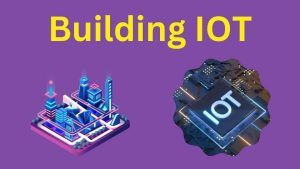Introduction

The advent of the Internet of Things (IoT) has significantly altered the landscape of modern architecture and infrastructure. Building IoT, a key component of this technological revolution, represents the integration of IoT devices and technologies within buildings to create dynamic, responsive, and intelligent environments.
This article aims to provide a comprehensive exploration of Building IoT, examining its role in enhancing building functionality, the challenges it faces, and its potential in shaping the future of smart infrastructure.
Unveiling the Concept of Building IoT
Building IoT encompasses the incorporation of various IoT technologies into the structural and operational fabric of buildings.
It involves a complex network of interconnected sensors, actuators, controllers, and communication systems designed to collect, analyze, and act upon data in real-time.
This system enables buildings to respond to internal and external stimuli, thereby optimizing their performance in terms of energy efficiency, comfort, and overall functionality.
The Anatomy of Building IoT
- Sensors: These devices gather data on various environmental parameters such as temperature, humidity, light, and occupancy.
- Actuators: Actuators respond to the data collected by sensors to regulate building systems like heating, ventilation, and air conditioning (HVAC), lighting, and security.
- Controllers: Controllers serve as the brain of the Building IoT system, processing the data from sensors and sending appropriate commands to actuators.
- Connectivity: This refers to the network infrastructure that facilitates communication between the different components of the Building-IoT system.
Advantages of Implementing Building IoT
The integration of IoT in buildings brings about numerous benefits, significantly enhancing their efficiency, sustainability, and the overall experience of the occupants.
Elevating Energy Efficiency
One of the foremost advantages of Building IoT is its ability to optimize energy consumption. By intelligently controlling HVAC systems, lighting, and other energy-intensive processes, buildings can significantly reduce their energy usage, thereby lowering operational costs and contributing to environmental sustainability.
Boosting Occupant Comfort and Productivity
Building IoT systems can adapt and respond to the needs and preferences of occupants, creating environments that are not only comfortable but also conducive to productivity and well-being.
Streamlining Building Management
The automation and real-time monitoring capabilities of Building-IoT simplify the management and maintenance of buildings, reducing the need for manual interventions and improving operational efficiency.
Challenges and Considerations in Building IoT
Despite its numerous benefits, the implementation of Building-IoT is not without its challenges.
Security and Privacy Concerns
The interconnected nature of IoT devices raises significant concerns regarding data security and privacy. Ensuring the protection of sensitive information and safeguarding against cyber threats are critical aspects of building-IoT implementation.
Integration with Legacy Systems
Incorporating IoT technologies into existing buildings can be particularly challenging, as it often involves overcoming compatibility issues and addressing limitations in existing infrastructure.
Cost and Complexity
The initial investment required for implementing Building IoT, along with the complexity of the systems, can pose significant barriers, particularly for smaller organizations or older buildings.
Building IoT in Practice: Case Studies and Applications
Building-IoT finds application in a variety of scenarios, each demonstrating its potential to transform the way we interact with our built environment.
Smart Lighting Systems
These systems utilize IoT technology to adjust lighting based on factors such as occupancy and natural light levels, thereby enhancing energy efficiency and occupant comfort.
Intelligent HVAC Controls
IoT-enabled HVAC systems can optimize temperature and air quality settings in real-time, balancing the need for comfort with energy conservation.
Predictive Maintenance
By employing sensors to monitor the condition of building equipment, Building-IoT enables predictive maintenance, helping to preempt equipment failures and reduce downtime.
The Future Landscape of Building IoT
As we look towards the future, Building-IoT continues to evolve, shaped by emerging technologies and shifting societal needs.
The Convergence of AI and Machine Learning
The integration of artificial intelligence (AI) and machine learning with Building-IoT is expected to usher in a new era of even more intelligent and responsive building systems.
The Drive Towards Sustainable and Green Buildings
Building-IoT is playing an increasingly crucial role in the pursuit of sustainability, aiding in the reduction of carbon footprints and promoting environmentally friendly practices in building operations.
The Impact of 5G and Edge Computing
The advent of 5G and edge computing technologies promises to enhance the speed, reliability, and efficiency of Building IoT networks, further expanding their capabilities and applications.
Frequently Asked Questions
What is the primary objective of Building IoT?
The primary objective of Building-IoT is to enhance the functionality, efficiency, sustainability, and occupant experience of buildings through the integration of interconnected IoT devices and systems.
How does Building IoT contribute to environmental sustainability?
Building-IoT contributes to sustainability by optimizing energy consumption, reducing waste, and supporting eco-friendly practices in building operations, ultimately leading to a reduced environmental footprint.
What are the key challenges in implementing Building IoT?
Key challenges in implementing Building-IoT include addressing security and privacy concerns, integrating with existing building systems, and managing the cost and complexity of IoT solutions.
Is it feasible to implement Building IoT in older buildings?
Yes, Building-IoT can be implemented in older buildings, although it may require additional considerations regarding compatibility with existing infrastructure and potential modifications to accommodate IoT technologies.
Conclusion: Building IoT as a Catalyst for Change
Building IoT represents more than just a technological innovation; it signifies a fundamental shift in our approach to designing and managing the built environment.
As we continue to explore and develop in this domain, the potential for smarter, more efficient, and sustainable buildings becomes ever more apparent.
With its ability to enhance energy efficiency, occupant comfort, and operational effectiveness, Building-IoT is not only redefining the standards of modern architecture but also paving the way for a more connected and responsive future.
The challenges it presents, such as security concerns, integration complexities, and cost considerations, are significant yet surmountable obstacles in the path toward a more intelligent and sustainable built environment.
As technology advances and society evolves, Building IoT stands poised to play a crucial role in shaping the buildings of tomorrow, embodying the convergence of innovation, sustainability, and human-centric design.
